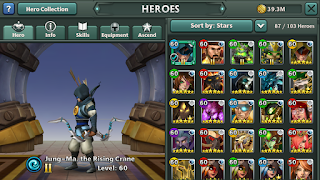As to why, we completed and shipped the entirety of Eon Altar Season 1. From start to finish it was an incredibly ambitious project, and the fact that we finished and shipped it is, frankly, massive. Add to that a 92% positive rating on Steam, and I can say without equivocation that I am proud of what we shipped. That said, it was 4 years of my life, and, among other reasons, I figured it was time to get some other industry experience.
Looking Back
If someone tells you that they want to build an RPG in a year, then says it's also going to have a completely unique game mechanic/control style, laugh at them. Seriously, just shake your head and laugh. Our original schedule was stupid, for the lack of a better term. It left no room or time for iteration, and at the end of the process we used up over 3.5 years total to get it out the door in its entirety. That said, I don't regret it--at all. What it did mean, though, was going from a team of 25+ people to a team of 4-5 people for the latter 2 years, and that's hard.
The extra time was necessary. It allowed us to polish up a lot of features, add missing bits and pieces, and actually iterate on the combat and gameplay formulas. You'd be impressed at the amount of work so few people can do. It also helps that the core team was mostly on the same page as to the direction of the game, which meant very little communication overhead. Sure, diversity of viewpoints is super useful (and when our team was bigger, it WAS useful), but I found it was more useful early in the process rather than late. Once you're in the polish phase, it's mostly mechanical work. User feedback, bug fixes, small adjustments because you can't afford rewrites.
But having so few people also meant we were stuck wearing a lot of hats. By the end, I was our tech support, forum moderator/community manager, lead programmer, project manager, QA Lead, QA Tester, copy writer, copy editor, IT administrator, build and deployment engineer. The list goes on. It was a little overwhelming at times, though I got an immense amount of experience doing it.
But even for just the engineering, working on Eon was an amazing process of learning something entirely different every day, and immediately applying it. One day I might be working on the combat engine. The next, code optimizations. On day 3, save games. Day 4, Steam integration. Day 5, animation bugs. I was never bored, because I was constantly learning. It was also exhausting, because I never got to revel in what I learned; I was always on the edge.
But damn, did we ever pull it out. Nobody--nobody--in the industry was doing what we did. Light role-playing meets local co-op video game was a unique mix, and the mobile controllers went far and beyond what JackBox did (though JackBox is amazing and I love it to bits), so we didn't have anyone to copy from. I even got to do a talk at PAX DEV about the process, which was fantastic. Such a great experience, and people apparently got some useful information out of the talk which was icing on the cake.
And that gameplay resonated with a fair number of people. Our reviews are generally extremely positive about the unique play that Eon Altar brought to the table. We even had an unintended but amazing audience segment: spouses. The number of reviews that talk about people playing with their significant others--many of them non-gamers, no less--and how much fun they had was so mind-blowing. We had made an RPG-lite that was approachable and fun, with enough depth that even hardcore players could have some fun min-maxing.
So what's next for Eon Altar? I can't say. That's up to the remaining team, and I wish them all the luck in the future. Eon is a fantastic project, a fascinating method of gameplay, and a great property. Yeah, we made mistakes, and the game itself is far from perfect, but I don't regret the project whatsoever. It will always be my dream project.
Moving Forward
So what's next for me? I've been hired as a Senior Engineer for an independent studio here in Vancouver, BC. The studio is large enough that I'll be able to focus on engineering almost exclusively, and been around long enough that they have a stable business plan to support those employees. I can't talk about my next project within the studio, but I am excited to work in an office again, with other programmers.
While I can learn a lot about gamedev on my own, improving one's programming and software engineering is difficult to in what's effectively a vacuum. Basically, when given a specific problem, it's relatively easy to learn or deduce how to solve it, but things like programming tools, style, practices, etc. are difficult to learn because you don't necessarily need them to complete your work. Your work becomes better with said knowledge, but it's not strictly necessary.
I'll be keeping an eye out for my former coworkers though, and see how Eon Altar fares moving forward. Eon Altar is a high bar to meet in terms of interesting engineering/design projects, and I'm not sure anything I work on in the near future will meet that bar, but that doesn't mean I won't be giving my new projects my all--I've far too much professional pride to do otherwise. But being able to focus primarily on engineering also frees up brain cycles for other things, like maybe blog posts? We'll see, I definitely miss blogging about game design stuff! But tomorrow, new job!





















